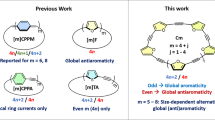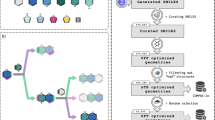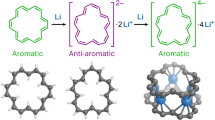Abstract
RECENTLY it has been shown1 that the two ideas of aromatic character and the aromatic sextet, which are generally associated in current theory, are not necessarily connected and that in addition to the well-known pπ–pπ bonding of the cyclic polyenes and aromatic hydrocarbons there is a second type, dπ–pπ bonding, which is exemplified notably by the phosphonitrilic halides. The two types have been termed2 ‘homomorphic’ and ‘heteromorphic’, respectively, and it has been demonstrated1,2 that, in terms of the site-symmetry of the atomic orbitals combined to form molecular π-orbitals, there are only these two forms of cyclic π-bonding.
This is a preview of subscription content, access via your institution
Access options
Subscribe to this journal
Receive 51 print issues and online access
$199.00 per year
only $3.90 per issue
Buy this article
- Purchase on Springer Link
- Instant access to full article PDF
Prices may be subject to local taxes which are calculated during checkout
Similar content being viewed by others
References
Craig, D. P., and Paddock, N. L., Nature, 181, 1052 (1958).
Craig, D. P., J. Chem. Soc., 997 (1959).
Lennard-Jones, J. E., Proc. Roy. Soc., A, 158, 280 (1937).
Heilbronner, E., Tetrahedron Letters, No. 29, 1923 (1964).
Markl, Angew. Chem., 2, 153, 479 (1963); 3, 147 (1964).
Author information
Authors and Affiliations
Rights and permissions
About this article
Cite this article
MASON, S. New Types of Aromaticity. Nature 205, 495–496 (1965). https://doi.org/10.1038/205495a0
Published:
Issue Date:
DOI: https://doi.org/10.1038/205495a0
This article is cited by
-
The golden jubilee of the Coulson-Rushbrooke pairing theorem
Journal of Mathematical Chemistry (1990)
-
Bond-alternating H�ckel-M�bius and related, twisted linear, cyclic and helical systems?their molecular orbitals, energies and phase correlation upon dissociation
Theoretica Chimica Acta (1983)
-
Cyclic Delocalization of Electrons in Molecules
Nature Physical Science (1971)
-
Hückel Molecular Orbital Models for Heterocycles with Tetra-coordinated Phosphorus Atoms
Nature (1968)
Comments
By submitting a comment you agree to abide by our Terms and Community Guidelines. If you find something abusive or that does not comply with our terms or guidelines please flag it as inappropriate.



